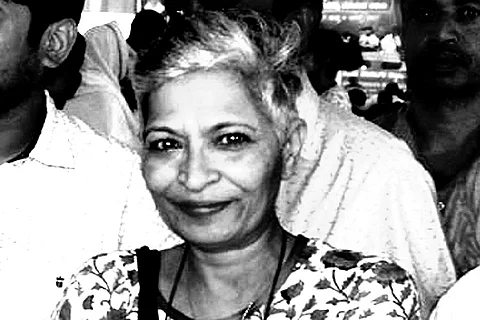

Karavali Ale is a Kannada newspaper published out of Mangaluru for the last 25 years and is circulated mainly in Dakshina Kannada district of Karnataka and Kasargode in Kerala, where a significant Kannada-knowing population lives.
The newspaper has run into trouble several times with right wing fringe groups, who have assaulted their circulation staff and taken away the bundles of newspapers to hurt where it will hurt the small publication house.
In 2013, two staffers were beaten up by activists of Hindu Jagaran Vedike who were angry over critical stories published in Karavali Ale and they had to be hospitalised for two weeks.
In 2009, when the BS Yeddyurappa government was in power, Karavali Ale editor BV Seetaram was handcuffed and arrested only because he had reportedly missed a couple of hearings in a defamation case against a BJP leader in court. One person who supported and stood by his side at that time, Seetaram points out, was Gauri Lankesh.
But the intimidation has had its effect.
"We are now afraid of publishing material critical of the Sangh Parivar elements because of the nationwide vigilance by right wing groups. Yes, certain things have to be told and we do so because we are an independent newspaper with a circulation of 45000 copies but yes, the element of fear exists,'' says Seetaram.
With Gauri Lankesh, those opposed to her journalism of courage and dissent, seem to have decided to go a step further and pull the trigger. Emboldened, also by the fact that the killers of rationalist MM Kalburgi in August 2015 and those who silenced anti-superstition activist Narendra Dabholkar in Pune in August 2013, have managed to cock a snook at the law so far. Both cases remain unsolved.
The message to the journalists and the thinking class is chilling: The pen may be yours but we decide on the ink. That makes India an unsafe territory for journalists.
This May, The Hoot released a report that pointed out that between January 2016 and April 2017, there had been 54 reported attacks on journalists in India and 45 cases of sedition slapped on individuals and groups.
Of the seven journalists killed in the period, one of the murders was clearly related to his journalistic work.
Go back a little and you hear the chilling story of Hemant Yadav, a journalist with a Hindi news channel TV24 who was shot dead by two assailants on a bike in October 2015 in Dheena in Uttar Pradesh.
The police told the media that it seemed to be a case of revenge as Hemant had taken up local issues and his activist journalism could have miffed someone influential. Hemant's murder was preceded by the brutal killing of freelance journalist Jagendra Singh who was doused with petrol and set on fire in Shahjahanpur in June.
The needle of suspicion pointed to a minister about whom he had written a story - Jagendra had accused the minister of being involved in illegal mining and land grabbing. The same month, TV journalist Haider Khan was tied to a motorcycle and dragged along the road in Pilibhit district. The attack was linked to his articles on dubious land deals in the district.
In Chhattisgarh, you will find journalists speak of making peace with their profession. A couple of years ago, travelling through Bastar, I met Satish Chandak, a young journalist in Sukma. He told me his pen is powerless in front of the gun - both state and the Maoist.
"Our limits have been defined. We have decided that we will not write beyond those self-defined boundaries. On one hand, naxals killed two of our colleagues and on the other, the Chhattisgarh police have also arrested few journalists,'' said Satish.
His colleague, Salim Shaikh, admitted that honest journalism has taken a hit and that reporters get reduced to writing puff pieces for the government. "The news organisation does not support you if you get on the wrong side of the police.So the organisation's order is that you should not highlight any police atrocities,'' said Salim.
Around the same period, journalist Malini Subramaniam was forced by vigilante groups, privately supported by the police, to exit Chhattisgarh and go back to her home in Hyderabad.
While it is not yet established whether Lankesh's murder was linked to her journalistic work, her elimination in the context of the kind of journalism she did, will mean investigative journalism could become a casualty.
There is already a realisation that investigative reportage is dangerous, with physical attacks being a direct fallout.
It is more so for vernacular journalists while the English media journalists are targeted online in the virtual world.
"Journalists are increasingly the targets of online smear campaigns by the most radical nationalists, who vilify them and even threaten physical reprisals,'' said Reporters Without Borders in its 2017 World Press Freedom Ranking.
India figures at 136 in a list of 192 countries in this report, the yardstick being the amount of freedom journalists have in a country.
A day after Gauri Lankesh was killed, a businessman from a town in central Karnataka told me, "Such small publications often indulge in yellow journalism and blackmail. Do you think it could be a case of the victim taking revenge?''
Having silenced Gauri for ever, the next step to tarnish her brand of journalism also seems to have begun in right earnest.
RIP Gauri Lankesh. I only hope India does not end up saying RIP Journalism some day.
Note: Views expressed are personal opinions of the author.